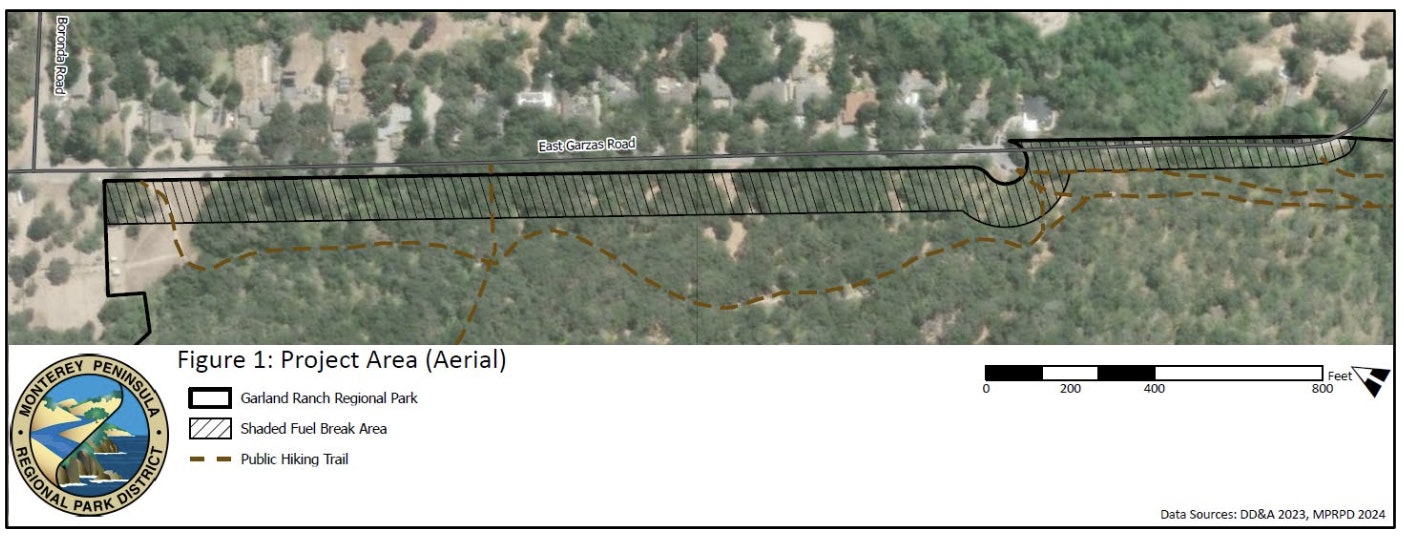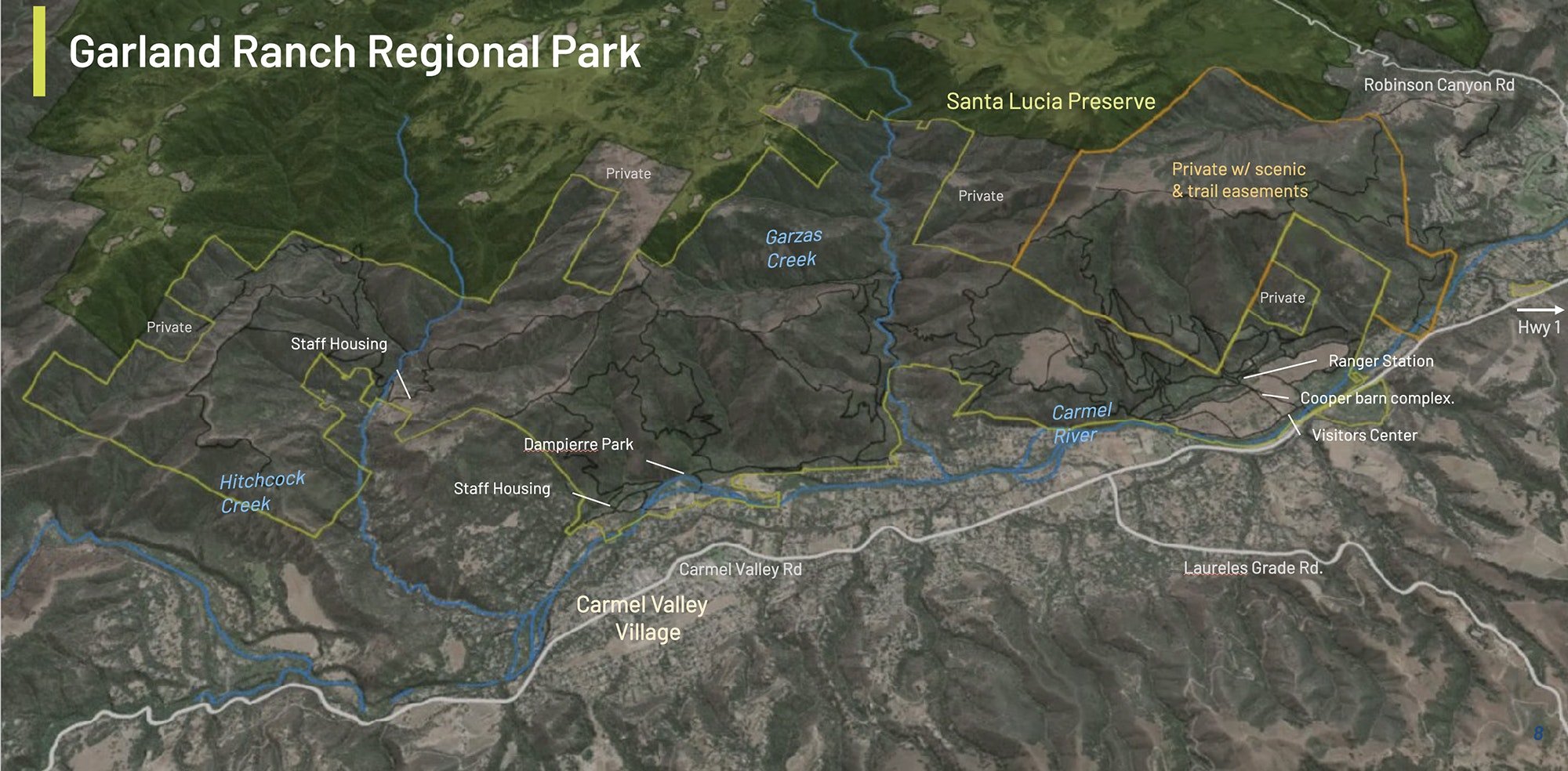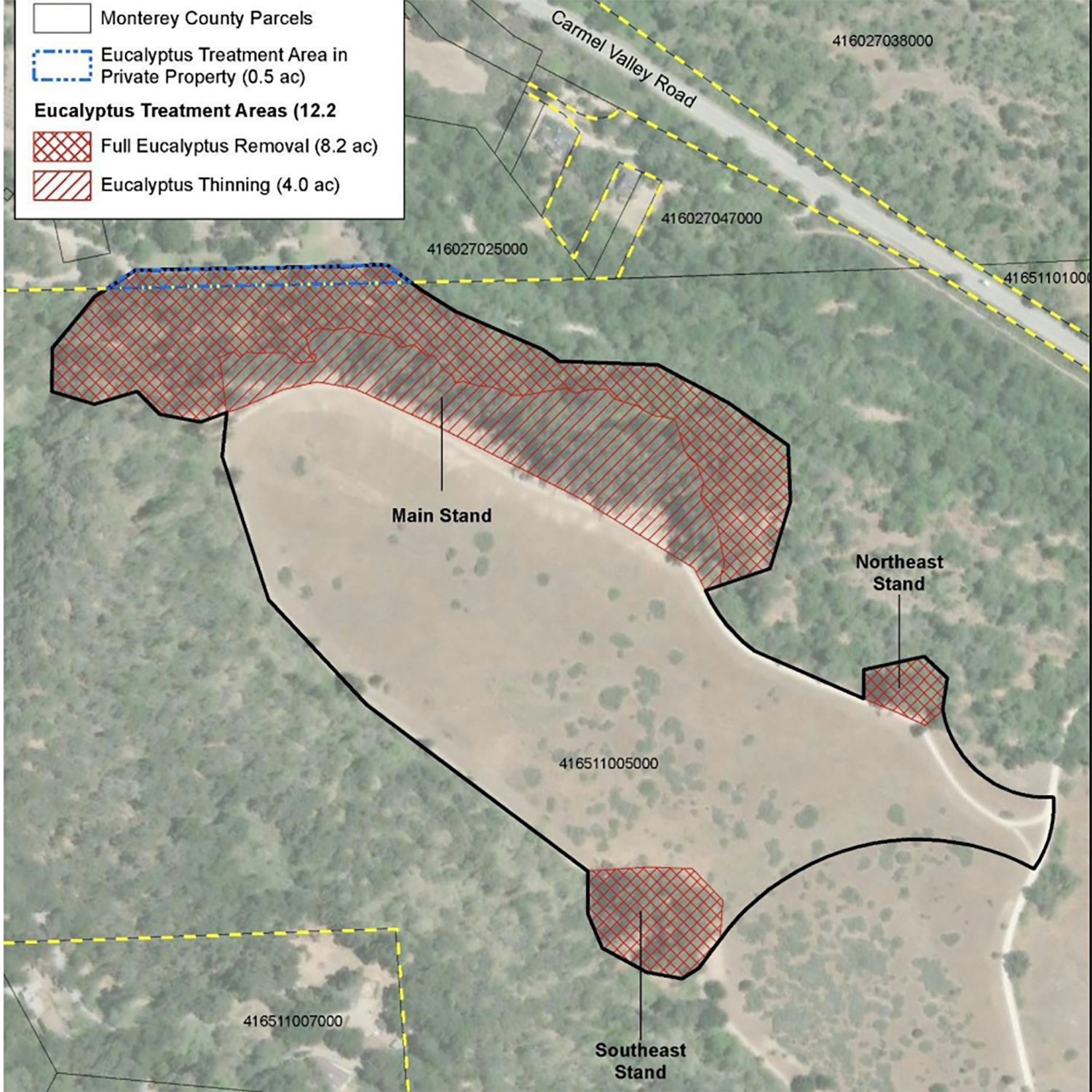Wildfire Preparedness and Fuel Management

Making our Parks and Communities Wildfire Resilient
The Monterey Peninsula Regional Park District (MPRPD) is dedicated to enhancing the resilience of our parks and communities against the increasing threat of wildfires. Since 1972, the District has been committed to stewarding the unique landscapes of the Monterey Peninsula. As wildfires become more severe, the District is expanding its fuel management and wildfire preparedness efforts to ensure these vital lands remain safe and enjoyable for the community.
Overview of Fuel Management and Wildfire Preparedness
Fuel management and wildfire preparedness are critical components of maintaining the health and safety of our parklands and nearby communities. Fuel management involves reducing the amount of flammable vegetation (fuels) to decrease the intensity and spread of wildfires. Wildfire preparedness encompasses planning and implementing strategies to protect both natural resources and human communities from the devastating effects of wildfires.
Treatment Priorities
Our landscapes have evolved to coexist with fire, relying on periodic wildfires to maintain fuel levels and landscape health. However, rising temperatures, prolonged droughts, urban development in fire-prone areas, and over a century of fire suppression have led to higher fuel loads and a greater risk of more severe wildfires that can cause catastrophic damage. To address this, we work to reduce excess vegetation near communities to improve safety and prepare our parks so that when fires do occur, they burn with lower intensity and in a more controlled manner. This can include activities such as thinning trees, removing underbrush, managing invasive species, intentionally burning areas in a controlled manner, and increasing firefighters’ ability to access areas that are critical for responding to wildfire events.
Funding
MPRPD uses funding it receives from property taxes, grants, and charitable contributions to conduct annual maintenance while also planning and advancing larger and more impactful projects in coordination with partner organizations. This combined approach seeks to fund baseline levels of wildfire protection while also making investments enhancing the quality, reach, and impact of our services beyond our own property boundaries. Through these efforts, we seek to maximize the value of every dollar paid by local taxpayers and strengthen our capacity to maintain and improve our parks.
Collaborative Efforts and Strategic Initiatives
In collaboration with state, federal, and local fire and resource experts, the District is accelerating initiatives to improve forest health and reduce fire risks. These efforts are essential to mitigate catastrophic wildfires that threaten our parks and communities. By forming strategic partnerships, expanding our skilled workforce, and securing additional funding, we are working towards the statewide goal of treating 1 million acres annually by 2025.

Benefits of Fuel Management and Wildfire Preparedness
The fuel reduction and wildfire preparedness efforts can provide multiple benefits to the community:
- Increased Wildfire Resilience: Managing vegetation to reduce fire intensity and spread, developing incident response plans in coordination with emergency responders, reducing the risk and severity of wildfires and ensuring that areas can withstand and recover from wildfires when they do occur.
- Enhanced Native Habitats: Reducing unnaturally high fuel loads and removing invasive, flammable non-native species like eucalyptus will help native plant communities recover and thrive after wildfires. This enhances ecosystem health and biodiversity, supporting more resilient landscapes.
- Watershed Protection: Efforts to reduce the size and severity of wildfire in our watershed will help protect our waterways from erosion and degradation that can impact aquatic species like Steelhead Trout and the quality of our local water supplies.
- Community Safety: Reducing the risk and severity of wildfires through active vegetation management, creating defensible space, and improving access for firefighters enhances the safety of our surrounding community.
- Scenic Preservation: By protecting and fostering the health, diversity, and resilience of native plants and wildlife, we ensure they thrive and continue to serve as the beautiful backdrop to our community.
- Public Education: Our parks provide opportunities to educate visitors and local residents about wildfire preparedness and how fuel reduction in our parks complements essential defensible space strategies throughout built communities.
By addressing high-risk areas, benefiting both public lands and nearby communities, and enhancing long-term ecological resilience, these projects align closely with state and regional priorities for wildfire risk reduction. This approach provides multiple benefits beyond wildfire risk reduction and demonstrates the MPRPD’s commitment to responsible stewardship of this vital public open space.
Key Projects
With technical support from the Resource Conservation District of Monterey County and funding from the State Coastal Conservancy, we are currently focused on two key projects in areas of Garland Ranch Regional Park along East Garzas Road. These projects, set to begin as soon as later this year, are examples of the types of projects that will be included as part of our upcoming Fuel Mitigation and Fire Management Plan for Garland Ranch Regional Park, which the District will be sharing with the community in winter 2024/2025.
To date, MPRPD has successfully won over $590,000 in grant funding from the State Coastal Conservancy's Wildfire Resilience Grant Program to support critical fuel reduction projects in Garland Ranch Regional Park. This program supports the development and implementation of projects that improve forest health and reduce the risk of catastrophic fire in areas where people are living near wildlands.

Garland Ranch Regional Park East Garzas Road Shaded Fuel Break Project
The Garland Ranch Regional Park East Garzas Road Shaded Fuel Break Project focuses on creating a 6.2-acre shaded fuel break in areas adjacent to East Garzas Road in Carmel Valley, California. The primary goal is to reduce wildfire risk by:
- Pruning tree limbs that are near the ground
- Trimming back shrubs and woody vegetation in the forest understory
- Removing invasive weeds and other nonnative vegetation
- Chipping and scattering cleared vegetation
This project is estimated to cost approximately $80,000 and is funded by the State Coastal Conservancy's Wildfire Resilience Grant Program. The implementation is expected to start by October 2024 and will take approximately two weeks to complete, with maintenance of the shaded fuel break occurring every 1 to 3 years.

Garland Ranch Regional Park Fuel Management Project
This project aims to manage and reduce wildfire risk and enhance and restore native habitat by removing, thinning, and treating three stands of invasive blue gum Eucalyptus within a 12.2-acre area of the park. The activities include:
- Removing eucalyptus trees that are encroaching into native habitat
- Thinning and pruning eucalyptus tree
- Chipping eucalyptus bark and other woody debris in the understory
- Retaining native oak, riparian trees, and native shrubs
- Planting additional native plants for birds and pollinators
Once complete, the Garland Ranch Regional Park Fuel Management Project and East Garzas Road Shaded Fuel Break Project will provide:
- Increased Wildfire Resilience: Remove flammable eucalyptus and create shaded fuel breaks to reduce catastrophic wildfire risk, aligning with CalFire's high-risk area treatment goals.
- Enhanced Native Habitats: Remove invasive eucalyptus to allow native species recovery, improving ecosystem health and biodiversity.
- Watershed Protection: Implement fuel reduction along Carmel River to protect against post-wildfire erosion and degradation.
- Community Safety: Create defensible space and fuel breaks to improve resident safety and firefighter access.
- Scenic Preservation: Maintain park's natural beauty while keeping a portion of the eucalyptus grove.
- Long-Term Resilience: Ongoing maintenance to promote fire resilience and native habitat recovery.
- Public Education: Educate visitors and residents about wildfire preparedness and vegetation management for fire safety.
The project is estimated to cost approximately $1,000,000 and is partially funded by the State Coastal Conservancy's Wildfire Resilience Grant Program. The project is expected to occur as early as fall 2024 once full project funding is secured.

Collaborators
The Monterey Peninsula Regional Park District collaborates with many entities to achieve its wildfire preparedness goals, including:
- Resource Conservation District of Monterey County (RCDMC)
- State Coastal Conservancy
- CAL FIRE and local fire protection districts
- Fire Safe Council for Monterey County and local Firewise communities
Funding
The primary funding sources for these projects include:
- State Coastal Conservancy's Wildfire Resilience Grant Program
- CAL FIRE grants
- Monterey Peninsula Regional Park District budget allocations
learn more
MPRPD strives to be a leader in wildfire preparedness and resiliency. California faces a growing wildfire crisis, driven by climate change, poor historical land management, and increased development in fire-prone areas. In recent years, the state has experienced some of its most destructive wildfires. The frequency and intensity of these fires are expected to increase, with projections indicating that wildfires could burn 77% more acreage by the end of the century.
In response, California has implemented a comprehensive approach to wildfire preparedness and resilience:
- Wildfire and Forest Resilience Action Plan: This plan outlines strategies to enhance forest health, create defensible spaces, and harden homes against fires. The state aims to manage 500,000 acres annually through thinning, prescribed burns, and other forest health projects. The state will also support a shared strategy to improve conditions on 1-million acres across the state, including 500,000 acres on federal lands. Learn more about this plan from the California Wildfire & Forest Resilience Task Force. The Task Force has a strategy specifically for Sustainable Outdoor Recreation & Wildfire Resilience.
- Significant Financial Investments: Since 2019, California has invested nearly $3 billion into wildfire resilience programs, including $1 billion over five years specifically for forest health projects. Examples include State Coastal Conservancy's Wildfire Resilience Grant Program, the State Coastal Conservancy's Regional Forest and Fire Capacity Program, the California Forest Legacy Program, and the California Forest Improvement Program.
- Enhanced Firefighting Resources: The state has bolstered its firefighting capabilities with additional personnel, equipment, and modern technologies like Blackhawk helicopters for night operations.
- Legislative Actions: Laws such as SB 901 and AB 2344 have established ongoing funding and reporting requirements for wildfire prevention and resilience programs, ensuring accountability and continuous improvement.
These efforts reflect California's commitment to mitigating wildfire risks and protecting its communities, ecosystems, and infrastructure from future fire disasters.
Get Involved
Community Involvement and Support
Your involvement and support can make a significant difference in protecting our parks. Stay informed about these initiatives by visiting our website, where we will share more information and periodic updates. Subscribe to our newsletter and follow us on social media for the latest news and opportunities to get involved.
Donate to Support this Work
Your financial support is crucial in enhancing wildfire resilience and protecting the natural beauty of Monterey County. By donating to the Let's Go Outdoors Fund, you will help fund essential fire management and mitigation projects at our regional parks, ensuring the safety and preservation of our cherished open spaces. Your contribution will make a significant impact in safeguarding our community and environment from the devastating effects of wildfires. Learn more about donating at our Let’s Go Outdoors fundraising page.
Take Action!
Monterey County residents can take proactive steps to protect their homes and communities from wildfires. Consider the following actions you can take to enhance preparedness and resilience against wildfire threats:
- Tune in to the Fire Safe Council for Monterey County. This organization is focused on educating the public about wildfire risk and providing resources to reduce the danger.
- Work with your local fire district to conduct a defensible space evaluation and get advice for how to best prepare your home for wildfire.
- Connect with the Resource Conservation District of Monterey County to learn about resources available for landowners to improve resiliency against wildfires.
- At a minimum, clear vegetation and create defensible spaces around your home. Even better, implement fire-resistant landscaping techniques in your yard.
Commitment to the Future
Through collaboration and proactive measures, we are committed to strengthening our parks’ ability to withstand and recover from wildfires so they can continue to benefit future generations. Together, we can ensure that the natural beauty and ecological integrity of the Monterey Peninsula are preserved for years to come. By continuing these efforts, the Monterey Peninsula Regional Park District aims to create a safer, more resilient environment for both the park's natural resources and the surrounding communities.
Last Updated: 08/13/2024
